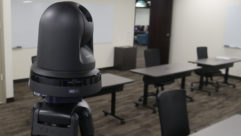Pedagogy And AV Technology
Pro AV technology has made great strides in adapting to teachers’ needs, but teachers must also learn to adapt to today’s technologies.
PRO AV TECHNOLOGY has always had a close relationship with teaching and training. Even before the electronic age, the AV industry was in large part driven by education. That fact remains, though the industry has now significantly broadened into other vertical markets.
The place of AV in education is tied to pedagogy. Throughout AV history, the industry has served the teaching profession to augment physical pedagogy. This occurred early on by allowing sound to be recorded and played back, enabling images to be enlarged, and ultimately allowing audio and video communication to occur over great distances.
The new center of the universe
During the last 50 years, and particularly in the last 20, a revolution developed in education, re-centering the educational universe from the lecturer to the learner. While this makes perfect sense now, it took a while for some teachers to get out of their one-way, face-front teaching style. Instead of sitting in chairs, staring glazed-eyed at a blackboard and lecturer, there are now group projects, group discussions, and learning games. The learner-centered model calls for more interaction and more self-paced, self-directed learning. All of this change was fueled by the onset of the information age and personal computers.
Another trend that developed in the past couple of decades was the need for more adult education. Industries were being created for which there was no formal path in traditional schools. Not only that, but there weren’t enough teachers available to teach these new subjects. Even people who learned their trade in formal education needed continuing education to keep up with the rapid rate of technological change.
All of this put a strain on old educational models, and created a need for new ways to teach more people. And pro AV came to the rescue.
A funny thing happened on the way to technology
But as the pro AV industry rode in on its white horse, not everything went as planned. New technology was developed, but wasn’t correctly applied. The technology wasn’t fully evolved, and people didn’t really know how to use it. This caused a lot of trouble for users and AV providers alike. And as the technology matured, other trends emerged. One was a sort of bandwagon mentality that, while profitable for the AV industry, didn’t necessarily serve the end-users as many had hoped. Some organizations implemented distance education and sophisticated AV systems in their classrooms because they really needed it. Others did it simply because they could.
Yet, teaching still had to take place in rooms with all of this technology — sometimes locally, others via connection to remote sites. Some teachers essentially ignored the technology. Others embraced the technology making use of document cameras, web-based bulletin boards, email, electronic documents, and videoconferencing to enhance interactivity and the overall learning experience. For the early adopters, this came naturally. They were passionate teachers who liked to interact and entertain. The technology offered an opportunity to teach more students in ways that gave them more ways to learn. More importantly, it provided more ways for students to interact, both with the instructor and with their fellow students.
High-tech teachers still need to be good teachers
During the past 10 years or so, pro AV technology has matured significantly. This is true at the classroom level where projectors provide more lumens and more pixels. User interface designs have also improved, and videoconferencing is easier than ever before. It’s also true at the organization level, where tools for managing AV technology are being developed.
So, what does it take to apply technology in education? First it has to work, and then the teacher has to know how to use it. But good technology doesn’t compensate for poor instruction. The good news is that teachers can learn to be better teachers, with or without technology. But once they’re good teachers, they have more to learn when using AV technology as a part of their pedagogy.
Users must be learners, too
Today, there are teachers who are still loath to change. There are others who make use of all the available technologies, and make learning accessible and fun. Others just need some help to become comfortable with the technology available to them.
This dance between technology and teaching is a two-way street. On the AV side, we need to make the effort to understand the needs of our clients when we’re called upon to help. We can provide the technology, and design it to be as user friendly as possible. We can help clients see the difference between the need for videoconferencing and web-based training with audio, and perhaps save them a lot of money. We can also help develop technical support strategies that make using technology less frustrating.
Another area where AV providers can help is in training the trainers, teachers, presenters, and technicians in how to use the technology — an area where more professional effort is needed than ever before. A one-hour tour of the AV system and text procedures may not be sufficient.
In addition to the traditional technical training, we should embrace the real pedagogical aspects of technically enhanced training — not just the technical aspects of using AV in education. Here are some examples:
- Making a PowerPoint presentation into something other than an outline.
- Using a document camera instead of a white-board when video projection and videoconferencing is being used.
- Avoiding “talking head” production styles when delivering video courses and seminars.
- Avoiding open-ended questions and calling on individuals by name in distance education scenarios to enhance interactivity.
Beyond the basics of good instructional design and classroom presence, the “21st century” teacher needs all of these skills. The AV industry needs to address both the pedagogical and technical needs of end-users, and we should bring the resources to accomplish this into the pro AV fold. In this regard, teachers need to learn just as much as students do, but we have to help. So, if you can read this, thank a teacher. If you can videoconference a course around the world, thank an AV professional. If you can do it well, teach the rest of us.
Tim Cape is a contributing editor for Pro AV, the principal consultant for Atlanta-based technology consulting firm Technitect LLC, and co-author of “AV Best Practices,” published by InfoComm International. He’s an instructor for the InfoComm International Audiovisual Design School and an active member of the consultant’s councils for both InfoComm International and NSCA. Contact him at [email protected].










